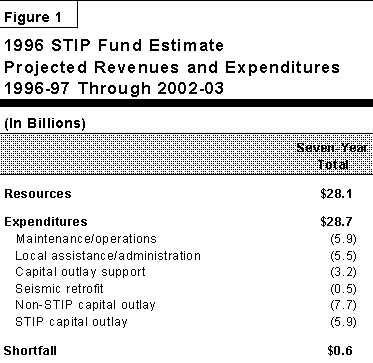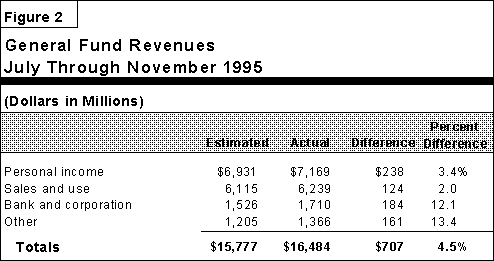Legislative Analyst's Office, December 1995

State Transportation Funding Shortfall
In August 1995, the California Transportation Commission (CTC) adopted a projection of revenues and expenditures for the state's transportation programs that
contains a $600 million shortfall. The projection (known as the 1996 Fund Estimate)
covers the seven-year period from 1996-97 through 2002-03 and is the basis for the
1996 State Transportation Improvement Program (STIP) which schedules transportation projects for design and construction during this period.
In this write-up, we provide an initial review of the 1996 Fund Estimate and actions
taken by the CTC to address the shortfall. We will further assess the magnitude of
the shortfall and its implications in the upcoming Analysis of the 1996-97 Budget
Bill in February 1996.
$600 Million Shortfall
The 1996 Fund Estimate projects that state and federal resources will total approximately $28.1 billion over the seven-year period, as shown in Figure 1. Expenditures,
however, are projected to total $28.7 billion, resulting in a shortfall of $600 million.
This projected level of expenditures includes noncapital outlays primarily for
highway maintenance and operation, local assistance and subventions, and Department of Transportation (Caltrans) administration. In addition, it includes the costs of
engineering, design, and construction of capital outlay projects previously scheduled
for funding by the CTC.

Implications of the Shortfall
In the absence of corrective action, the projected funding shortfall has the following
implications for the state transportation program:
- No New Projects. No new capital outlay projects will be added
to the last two years of the 1996 STIP period (2001-02 and 2002-03).
- Some Projects Not Funded. About $600 million in capital outlay
projects scheduled in previous STIPs will not receive funding within the 1996 STIP
period. Accordingly, the CTC has directed local and regional transportation planning
agencies to identify projects, based on priorities, for potential deletion. The earliest
that these projects could receive state and federal funding would be after 2002-03.
- Construction Delays. Projects that will be funded will experience
delays in construciton. For example, some projects originally scheduled to be funded
through 1998-99 will not be funded until 2002-03.
- Deferrals. Other transportation improvements, such as pavement
rehabilitation and maintenance, could potentially be deferred.
Why Is There a Funding Shortfall?
The funding shortfall is the result of overly optimistic resource projectins coupled
with underestimating expenditures. As a consequence, the state has scheduled more
transportation improvement projects for funding than it has available resources.
Prior Resources Estimates Too Optimistic. Past projections of
transportation resources have turned out to be overly optimistic, primarily due to the
following reasons:
- Recession. The economic downturn in the past few years led to
gas tax and weight fee revenues being about $1 billion below the level anticipated.
- Transportation Funds Used for Other Purposes. As part of the
state's overall budgetary solutions in the past several years, state transportation funds
were used for purposes other than transportation expenditures. For instance, state
transportation funds have been transferred to the General Fund for general purposes.
Additionally, transportation funds, rather than the General Fund, were used to pay
the debt service on rail bonds. These redirections reduced available resources for state
transportation programs by about $440 million since 1993-93.
- Failure of Rail Bond Measures. The 1992 STIP anticipated that
voters would approve $3 billion in rail bond funds for capital projects. However, only
$1 billion in bond funds were approved by the voters, leaving a $2 billion shortfall.
Unanticipated Expendiutres for High Priority Projects. In addition to
significantly lower-than-expected resources, unanticipated events have increased
transportation expenditures. In particular, as a result of the Loma Prieta and the
Northridge earthquakes, the state expanded its seismic retrofit efforts to make state
highway structures and toll bridges more eathquake-safe. Reallocating resources to
this high priority program reduces the amount available for other STIP projects.
How Realistic Is the 1996 Fund Estimate?
The 1996 Fund Estimate takes a more conservative approach to projecting resources
than previous Fund Estimates. Because it is a seven-year projection, however, there
are still many uncertainties. For instance, the current federal transportation act will
expire in 1997 -- one year into the 1996 STIP period. At present, it is uncertain what
funding level the new federal program will provide. Any reduction in federal funds
below the currently anticipated funding level would increase the shortfall accord
ingly.
Similarly, there are uncertainties regarding future expenditures. The fund Estimate,
for example, assumes significant expenditure reductions in the support budget for
Caltrans. Whether these reductions will be realized depend on efficiency measures to
be implemented by the department, many of which are unknown at this time.
Additionally, the Fund Estimate assumes that about $650 million in seismic retrofit
expenditures for state-owned toll bridges would be paid for from funds other than
state and federal highway monies. To the extent that these funds are not available,
the shortfall would increase.
Bond Measure Would Alleviate Problem
Proposition 192 -- the Seismic Retrofit Bond Act of 1996 -- will be on the March 1996
primary election ballot. If approved by the voters, it would authorize the state to sell
$2 billion in general obligation bonds in order to retrofit state-owned highways,
bridges, and toll bridges. Funding seismic retrofit work out of bond funds would, in
turn, eliminate the funding shortfall. As a result, there would not be a need to delete
projects. furthermore, some non-seismic-retrofit projects could be funded at an earlier
time than currently estimated.
Contact -- Kim McCord -- (916) 445-5921
Economic and Revenue Developments
Economy Continues to Expand. Recent developments suggest
that the California economy is continuing to expand at a moderate rate. Wage and
salary employment increased by 9,000 in November, and is now up by more than
300,000 from last year at this time. The unemployment rate jumped by a full percent
age point to 8.8 percent during the month; however, the increase appears to be a
statistical anomaly rather than a meaningful indicator of labor market conditions. In
fact, the Employment Development Department has indicated that, beginning in
January, it will be modifying its method of estimating the state's unemployment rate,
partly in response to the increased monthly volatility that the series has been
showing.
In other economic developments, home sales increased during October to the highest
level of 1995, and retail spending during the early fall continued to show moderate
year-over-year increases. However, construction of new homes remained weak during
October, continuing a trand that has persisted throughout 1995.
Revenues Up Again. General Fund revenues exceeded the 1995-96
budget estimate by $32 million in November, bringing total collections for the first
five months of the fiscal year to $707 million above the forecast. It appears that over
$600 million of the year-to-date gain is permanent, with the balance being temporary
and reflecting cash-flow factors.
As shown in Fingure 2, each of the state's major taxes are running significantly
above estimates. This refects stronger-that-expected retail spending, employment,
income, and corporation earnings in California during the second half of 1995.

Revenue collections from December through early February will be key determinates
of the overall 1995-96 revenue picture. During these months, individuals and corporations make the last prepayment twoard their 1995 tax liabilities, and retailers remit
sales tax payments related to the important 1995 Christmas shopping season.
Contact -- Brad Williams -- (916) 324-4942
Return to LAO Home Page
Return to LAO Home Page �



